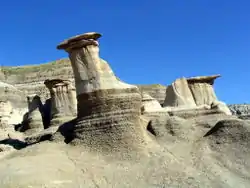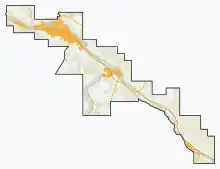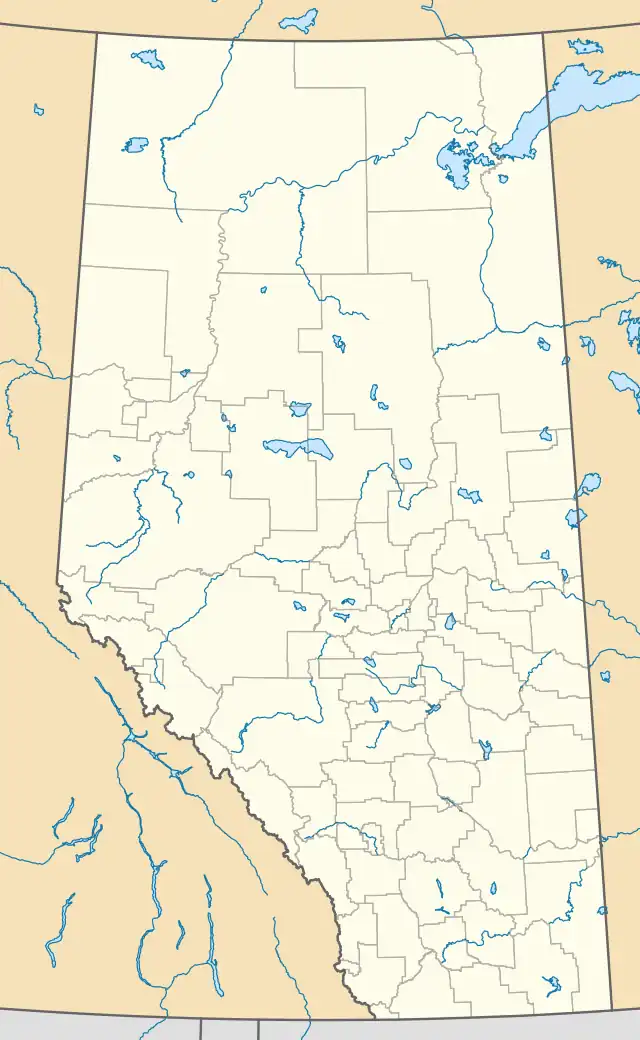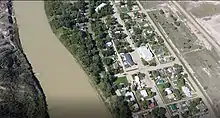East Coulee | |
|---|---|
 Hoodoos near East Coulee | |
 East Coulee  East Coulee | |
| Coordinates: 51°20′10″N 112°29′24″W / 51.336°N 112.490°W | |
| Country | Canada |
| Province | Alberta |
| Municipality | Town of Drumheller |
| Government | |
| • Mayor | Heather Colberg |
| • Governing body | Drumheller Town Council
|
| Area | |
| • Land | 1.39 km2 (0.54 sq mi) |
| Elevation | 675 m (2,215 ft) |
| Population (2016)[2] | |
| • Total | 148 |
| Time zone | UTC−7 (MST) |
| • Summer (DST) | UTC−6 (MDT) |
| Area code(s) | 403, 587, 825 |
East Coulee is a community within the Town of Drumheller, Alberta, Canada. It was previously a hamlet within the former Municipal District (MD) of Badlands No. 7[3] prior to the MD's amalgamation with the former City of Drumheller on January 1, 1998.[4] It is also recognized as a designated place by Statistics Canada.[5]
East Coulee is located on Highway 10, approximately 20 km (12 mi) southeast of Drumheller's main townsite and 112 km (70 mi) northeast of Calgary. It lies in the Red Deer River valley and has an elevation of 675 m (2,215 ft). The community is within Census Division No. 5 and in the federal riding of Crowfoot.
It was one of the filming locations of the television series MythQuest.

History
During its peak years around 1930 and again later in the mid-1940s, East Coulee was home to over 3,000 residents and dozens of thriving businesses. In the mid-1950s, however, its population began to plummet and its business count dropped to three—a hotel, a garage and a grocery store. By 1970, the community's school had closed.
As with other coal communities, East Coulee's demise began in the 1950s due to the combination of expanding oil and natural gas industries and the transition of many industries to fuels other than coal. The reduced demand for the valley's coal resulted in the closure of all Drumheller area mines at the time except for the Atlas Mine at East Coulee. The Atlas Mine survived until 1979 as a severely scaled back version, decreasing from year-round to seasonal operation, and from employing more than 200 miners to having only 60 on the payroll. The mine's reduction in the 1950s sent much of the community's population to other areas in search of work, leaving an eerie mix of boarded-up buildings and abandoned mines amid the stark scenery of Alberta's badlands.</ref>
Demographics
| Year | Pop. | ±% |
|---|---|---|
| 1941 | 1,831 | — |
| 1951 | 1,217 | −33.5% |
| 1956 | 1,003 | −17.6% |
| 1961 | 683 | −31.9% |
| 1966 | 387 | −43.3% |
| 1971 | 312 | −19.4% |
| 1976 | 261 | −16.3% |
| 1981 | 218 | −16.5% |
| 1986 | 180 | −17.4% |
| 1991 | 175 | −2.8% |
| 1996 | 157 | −10.3% |
| 2001 | 156 | −0.6% |
| 2006 | 177 | +13.5% |
| 2011 | 140 | −20.9% |
| 2016 | 148 | +5.7% |
| Source: Statistics Canada [6][7][8][9][10][11][12][13][14][15][16][17][5][2] | ||
As a designated place in the 2016 Census of Population conducted by Statistics Canada, East Coulee recorded a population of 148 living in 87 of its 119 total private dwellings, a change of 5.7% from its 2011 population of 140. With a land area of 1.39 km2 (0.54 sq mi), it had a population density of 106.5/km2 (275.8/sq mi) in 2016.[2]
As a designated place in the 2011 Census, East Coulee had a population of 140 living in 77 of its 95 total dwellings, a −20.9% change from its 2006 population of 177. With a land area of 1.14 km2 (0.44 sq mi), it had a population density of 123/km2 (318/sq mi) in 2011.[5]
See also
Visited by Jeremy and Glynys and grandma in 1997
References
- ↑ "Municipal Officials Search". Alberta Municipal Affairs. May 9, 2019. Retrieved October 1, 2021.
- 1 2 3 4 "Population and dwelling counts, for Canada, provinces and territories, and designated places, 2016 and 2011 censuses – 100% data (Alberta)". Statistics Canada. February 8, 2017. Retrieved February 13, 2017.
- ↑ "Town of Drumheller Municipal Development Plan: Volume 1 Background Study" (PDF). Town of Drumheller and Palliser Regional Municipal Services. April 21, 2008. p. 5. Archived from the original on April 20, 2014. Retrieved October 10, 2013.
- ↑ "Location and History Profile: Town of Drumheller". Alberta Municipal Affairs. October 4, 2013. Retrieved October 10, 2013.
- 1 2 3 "Population and dwelling counts, for Canada, provinces and territories, and designated places, 2011 and 2006 censuses (Alberta)". Statistics Canada. 2012-02-08. Retrieved 2012-04-07.
- ↑ Ninth Census of Canada, 1951 (PDF). Vol. SP-7 (Population: Unincorporated villages and hamlets). Dominion Bureau of Statistics. March 31, 1954. pp. 55–57. Retrieved October 24, 2021.
- ↑ Census of Canada, 1956 (PDF). Vol. Population of unincorporated villages and settlements. Dominion Bureau of Statistics. October 25, 1957. pp. 56–59. Retrieved October 24, 2021.
- ↑ "Population of unincorporated places of 50 persons and over, Alberta, 1961 and 1956". 1961 Census of Canada: Population (PDF). Series SP: Unincorporated Villages. Vol. Bulletin SP—4. Ottawa: Dominion Bureau of Statistics. April 18, 1963. pp. 63–67. Retrieved October 24, 2021.
- ↑ "Population of unincorporated places of 50 persons and over, 1966 and 1961 (Alberta)". Census of Canada 1966: Population (PDF). Special Bulletin: Unincorporated Places. Vol. Bulletin S–3. Ottawa: Dominion Bureau of Statistics. August 1968. pp. 184–187. Retrieved October 24, 2021.
- ↑ "Population of Unincorporated Places of 50 persons and over, 1971 and 1966 (Alberta)". 1971 Census of Canada: Population. Special Bulletin: Unincorporated Settlements. Vol. Bulletin SP—1. Ottawa: Statistics Canada. March 1973. pp. 204–207.
- ↑ "Geographical Identification and Population for Unincorporated Places of 25 persons and over, 1971 and 1976". 1976 Census of Canada (PDF). Supplementary Bulletins: Geographic and Demographic (Population of Unincorporated Places—Canada). Vol. Bulletin 8SG.1. Ottawa: Statistics Canada. May 1978. Retrieved October 24, 2021.
- ↑ 1981 Census of Canada (PDF). Place name reference list. Vol. Western provinces and the Territories. Ottawa: Statistics Canada. May 1983. Retrieved November 14, 2021.
- ↑ 1986 Census of Canada (PDF). Population. Vol. Unincorporated Places. Ottawa: Statistics Canada. July 1988. Retrieved November 14, 2021.
- ↑ 91 Census (PDF). Population and Dwelling Counts. Vol. Unincorporated Places. Ottawa: Statistics Canada. June 1993. Retrieved November 14, 2021.
- ↑ 96 Census (PDF). Population and Dwelling Counts. Vol. A National Overview. Ottawa: Statistics Canada. April 1997. Retrieved November 14, 2021.
- ↑ "Population and Dwelling Counts, for Canada, Provinces and Territories, and Census Divisions, 2001 and 1996 Censuses - 100% Data (Alberta)". Statistics Canada. August 15, 2012. Retrieved November 14, 2021.
- ↑ "Population and dwelling counts, for Canada, provinces and territories, and designated places, 2006 and 2001 censuses - 100% data (Alberta)". Statistics Canada. July 20, 2021. Retrieved October 24, 2021.